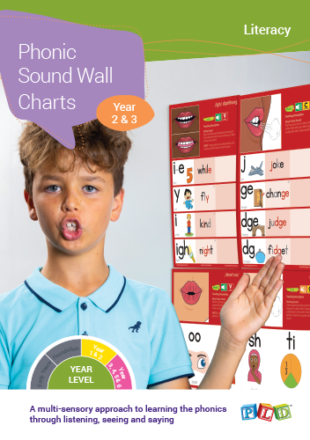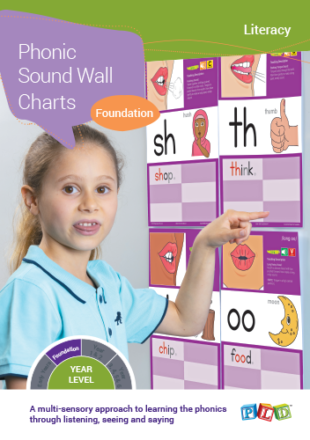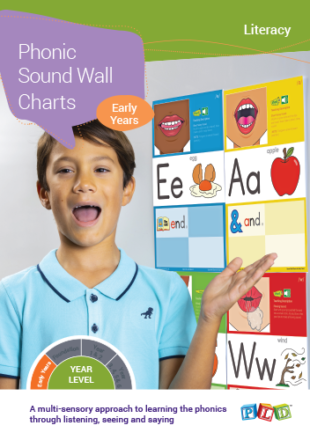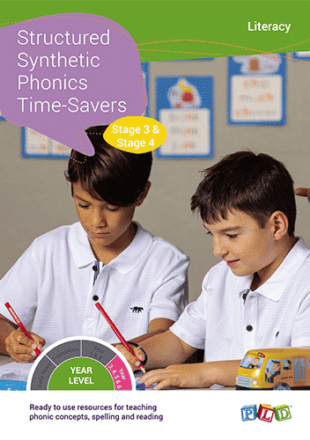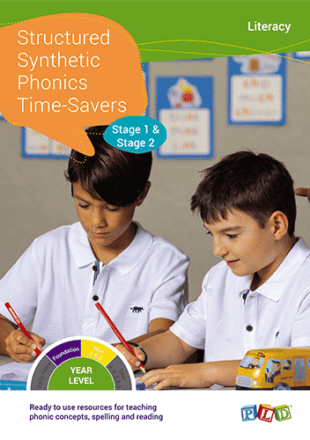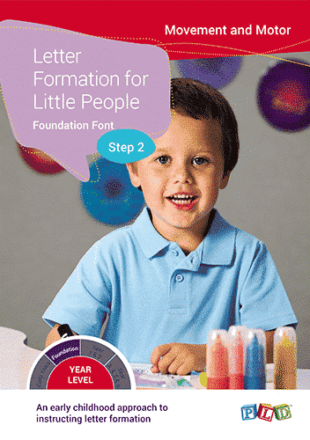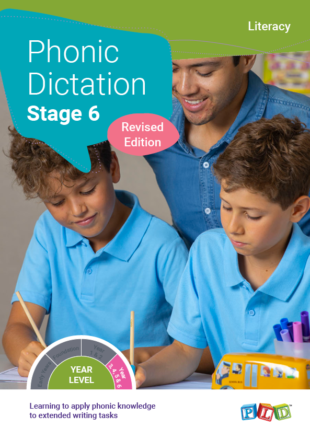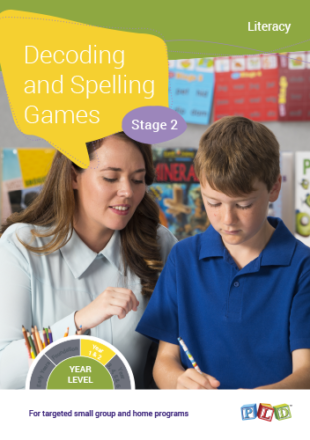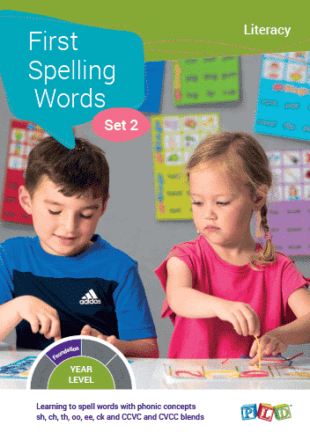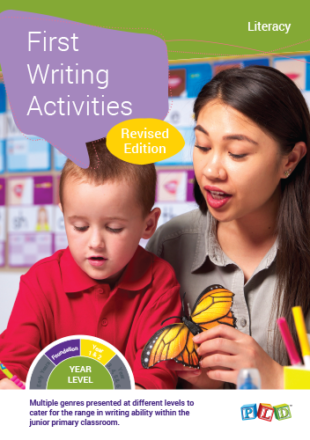Individual licence
Showing 65–80 of 116 results
-
Generating Narratives – Set 1 – Individual Licence
This is a PLD Individual Licence resource. By purchasing this licence, this program will be accessible as a digital flipbook that will be stored in your secure account on the PLD website and may only be accessed by an individual user, being the Purchaser. The program will be accessible as a digital flipbook that can be accessed by the purchaser on any device for as long as the licence is active. An Individual Licence is valid for 12 months from the date of purchase. Sharing of an Individual Licence or account credentials for the purpose of sharing an Individual Licence is a breach of Australian Copyright Law and PLD Terms of Use. For more information, visit our Individual Licence FAQ.Building Verbal and Written Expression Through Picture Prompts Generating Narratives – Set 1 supports Year 1 to 6 students develop verbal and written storytelling skills.
$22.50 / month[flipbook-popup id=''][/flipbook-popup] -
Phonic Sound Wall Charts for Foundation – Individual Licence
This is a PLD Individual Licence resource. By purchasing this licence, this program will be accessible as a digital flipbook that will be stored in your secure account on the PLD website and may only be accessed by an individual user, being the Purchaser. The program will be accessible as a digital flipbook that can be accessed by the purchaser on any device for as long as the licence is active. An Individual Licence is valid for 12 months from the date of purchase. Sharing of an Individual Licence or account credentials for the purpose of sharing an Individual Licence is a breach of Australian Copyright Law and PLD Terms of Use. For more information, visit our Individual Licence FAQ.A multi-sensory approach to learning alphabet sounds through listening, seeing and saying. What are the features of PLD’s Sound Wall Charts? Teaching the 44 speech
$27.50 / year[flipbook-popup id=''][/flipbook-popup] -
Phonic Sound Wall Charts for Year 2 & 3
What are the features of PLD’s Sound Wall Charts? Teaching the 44 speech sounds of the English language requires accurate modelling and articulation, pedagogy that sound walls support. The PLD sound wall charts focus on the phonemes (or individual sounds) of speech and link to the PLD scheduled phonic sequence. Each phoneme-specific chart features: Charts focused upon the phonemes and phonics for an Early Years class. The corresponding visual of a mouth. A simple description (e.g. tongue tapping sound, lip popping sound, peeking tongue sound, coughing or huffing sound) A detailed description. Icons identifying if the phoneme is a long or short, quiet or noisy, or vowel or consonant sound. Areas to add words (making the charts interactive rather than static). The related phonic concepts for each year level. What is a sound wall display? A sound wall is an interactive display of phonic concepts and words that is organised by and/or emphasises individual sounds (phonemes). Commonly there is one wall for consonants and one for vowels. Sound walls focus on the formation of phonemes which gives young students a structure that helps them understand the foundation of language and written literacy. As we know from current research about the science of reading, children learn to read through the application of orthographic mapping, a speech-to-print process where letters are mapped to known speech sounds. Teachers need to harness this modern understanding by using sound wall displays as a teaching and learning tool in their classrooms to support the process of learning to read and spell. Other Sound Wall Charts Pack: Phonic Sound Wall Charts for the Early Years (26 A4 coloured charts which focus on the alphabet) Phonic Sound Wall Charts for Foundation (42 A4 coloured charts which focus on the alphabet and Stage 1 digraphs) Phonic Sound Wall Charts for Year 1 (49 A4 coloured charts which focus on Stage 1 & Stage 2 digraphs) Phonic Sound Wall Charts for Year 2 & 3 (71 A4 coloured charts which focus on Stage 1, Stage 2 & Stage 3 digraphs) Full Set of Phonic Sound Wall Charts Recommended Reading: Tips for Getting the Most Out of Sound Wall Charts Sound Walls & Structured Synthetic Phonics Programs
$55.00$55.00 incl. GST[flipbook-popup id=''][/flipbook-popup] -
Phonic Sound Wall Charts for Year 1
What are the features of PLD’s Sound Wall Charts? Teaching the 44 speech sounds of the English language requires accurate modelling and articulation, pedagogy that sound walls support. The PLD sound wall charts focus on the phonemes (or individual sounds) of speech and link to the PLD scheduled phonic sequence. Each phoneme-specific chart features: Charts focused upon the phonemes and phonics for an Early Years class. The corresponding visual of a mouth. A simple description (e.g. tongue tapping sound, lip popping sound, peeking tongue sound, coughing or huffing sound) A detailed description. Icons identifying if the phoneme is a long or short, quiet or noisy, or vowel or consonant sound. Areas to add words (making the charts interactive rather than static). The related phonic concepts for each year level. What is a sound wall display? A sound wall is an interactive display of phonic concepts and words that is organised by and/or emphasises individual sounds (phonemes). Commonly there is one wall for consonants and one for vowels. Sound walls focus on the formation of phonemes which gives young students a structure that helps them understand the foundation of language and written literacy. As we know from current research about the science of reading, children learn to read through the application of orthographic mapping, a speech-to-print process where letters are mapped to known speech sounds. Teachers need to harness this modern understanding by using sound wall displays as a teaching and learning tool in their classrooms to support the process of learning to read and spell. Other Sound Wall Charts: Phonic Sound Wall Charts for the Early Years (26 A4 coloured charts which focus on the alphabet) Phonic Sound Wall Charts for Foundation (42 A4 coloured charts which focus on the alphabet and Stage 1 digraphs) Phonic Sound Wall Charts for Year 1 (49 A4 coloured charts which focus on Stage 1 & Stage 2 digraphs) Phonic Sound Wall Charts for Year 2 & 3 (71 A4 coloured charts which focus on Stage 1, Stage 2 & Stage 3 digraphs) Full set of Phonic Sound Wall Charts Recommended Reading: Tips for Getting the Most Out of Sound Wall Charts Sound Walls & Structured Synthetic Phonics Programs
$55.00$55.00 incl. GST[flipbook-popup id=''][/flipbook-popup] -
Phonic Sound Wall Charts for Foundation
What are the features of PLD’s Sound Wall Charts? Teaching the 44 speech sounds of the English language requires accurate modelling and articulation, pedagogy that sound walls support. The PLD sound wall charts focus on the phonemes (or individual sounds) of speech and link to the PLD scheduled phonic sequence. Each phoneme-specific chart features: Charts focused upon the phonemes and phonics for a Foundation class. The corresponding visual of a mouth. A simple description (e.g. tongue tapping sound, lip popping sound, peeking tongue sound, coughing or huffing sound) A detailed description. Icons identifying if the phoneme is a long or short, quiet or noisy, or vowel or consonant sound. Areas to add words (making the charts interactive rather than static). The related phonic concepts for each year level. What is a sound wall display? A sound wall is an interactive display of phonic concepts and words that is organised by and/or emphasises individual sounds (phonemes). Commonly there is one wall for consonants and one for vowels. Sound walls focus on the formation of phonemes which gives young students a structure that helps them understand the foundation of language and written literacy. As we know from current research about the science of reading, children learn to read through the application of orthographic mapping, a speech-to-print process where letters are mapped to known speech sounds. Teachers need to harness this modern understanding by using sound wall displays as a teaching and learning tool in their classrooms to support the process of learning to read and spell. Other Sound Wall Charts: Phonic Sound Wall Charts for the Early Years (26 A4 coloured charts which focus on the alphabet) Phonic Sound Wall Charts for Foundation (42 A4 coloured charts which focus on the alphabet and Stage 1 digraphs) Phonic Sound Wall Charts for Year 1 (49 A4 coloured charts which focus on Stage 1 & Stage 2 digraphs) Phonic Sound Wall Charts for Year 2 & 3 (71 A4 coloured charts which focus on Stage 1, Stage 2 & Stage 3 digraphs) Full set of Phonic Sound Wall Charts Recommended Reading: Tips for Getting the Most Out of Sound Wall Charts Sound Walls & Structured Synthetic Phonics Programs
$55.00$55.00 incl. GST[flipbook-popup id=''][/flipbook-popup] -
Phonic Sound Wall Charts for Early Years
What are the features of PLD’s Sound Wall Charts? Teaching the 44 speech sounds of the English language requires accurate modelling and articulation, pedagogy that sound walls support. The PLD sound wall charts focus on the phonemes (or individual sounds) of speech and link to the PLD scheduled phonic sequence. Each phoneme-specific chart features: Charts focused upon the phonemes and phonics for an Early Years class. The corresponding visual of a mouth. A simple description (e.g. tongue tapping sound, lip popping sound, peeking tongue sound, coughing or huffing sound) A detailed description. Icons identifying if the phoneme is a long or short, quiet or noisy, or vowel or consonant sound. Areas to add words (making the charts interactive rather than static). The related phonic concepts for each year level. What is a sound wall display? A sound wall is an interactive display of phonic concepts and words that is organised by and/or emphasises individual sounds (phonemes). Commonly there is one wall for consonants and one for vowels. Sound walls focus on the formation of phonemes which gives young students a structure that helps them understand the foundation of language and written literacy. As we know from current research about the science of reading, children learn to read through the application of orthographic mapping, a speech-to-print process where letters are mapped to known speech sounds. Teachers need to harness this modern understanding by using sound wall displays as a teaching and learning tool in their classrooms to support the process of learning to read and spell. Other Sound Wall Charts: Phonic Sound Wall Charts for the Early Years (26 A4 coloured charts which focus on the alphabet) Phonic Sound Wall Charts for Foundation (42 A4 coloured charts which focus on the alphabet and Stage 1 digraphs) Phonic Sound Wall Charts for Year 1 (49 A4 coloured charts which focus on Stage 1 & Stage 2 digraphs) Phonic Sound Wall Charts for Year 2 & 3 (71 A4 coloured charts which focus on Stage 1, Stage 2 & Stage 3 digraphs) Full Set of Phonic Sound Wall Charts Recommended Reading: Tips for Getting the Most Out of Sound Wall Charts Sound Walls & Structured Synthetic Phonics Programs
$55.00$55.00 incl. GST[flipbook-popup id=''][/flipbook-popup] -
Decoding and Spelling Games – Stage 1 – Individual Licence
This is a PLD Individual Licence resource. By purchasing this licence, this program will be accessible as a digital flipbook that will be stored in your secure account on the PLD website and may only be accessed by an individual user, being the Purchaser. The program will be accessible as a digital flipbook that can be accessed by the purchaser on any device for as long as the licence is active. An Individual Licence is valid for 12 months from the date of purchase. Sharing of an Individual Licence or account credentials for the purpose of sharing an Individual Licence is a breach of Australian Copyright Law and PLD Terms of Use. For more information, visit our Individual Licence FAQ.A program to develop single word decoding and spelling skills for students operating at Stage 1. Games and tasks for targeted small groups and home
$41.25 / year[flipbook-popup id=''][/flipbook-popup] -
Structured Synthetic Phonics Time-Savers – Stage 3 & 4
The Structured Synthetic Phonics Time-Savers for Stage 3 & Stage 4 program is designed to save time, simplify planning and to support educators in delivering impactful phonics lessons with ease. Aligned with the Phonic and Sight Word Sequence, the program includes resources that simplify lesson planning while delivering high-quality phonics instruction. The program is designed to support spelling and reading development through explicit instruction, practise and revision, ensuring that students achieve success in early literacy. Program Includes: A4 book: Spiral-bound, full colour and no preparation required. Stage 3 & Stage 4 Colour-Coded Word Lists: Fully prepared, colour-coded spelling lists that highlight phonic patterns and sound structures for easy teaching and learning. Student-Friendly Spelling Lists: Smaller, colour-coded versions of the word lists are provided for students, enabling independent learning and consolidation of concepts. Flashcards for Phonics Concepts: Bright, engaging flashcards to introduce and reinforce phonics concepts effectively. Rapid Automatic Reading Tasks: Focused activities designed to improve reading accuracy, speed and fluency. Weekly Spelling Routines: Clear templates and activity guides to help structure spelling lessons and provide consistent practice. Other Programs within the Range: Structured Synthetic Phonics Time-Savers – Stage 1 & 2 Structured Synthetic Phonics Time-Savers – Stage 3 & 4 Structured Synthetic Phonics Time-Savers – Stage 5 & 6 Structured Synthetic Phonics Time-Savers Stage 1-4 Junior & Middle Primary Set Full Set of Structured Synthetic Phonics Time Savers Links to the Teaching Sequence Manuals: This product can be used to support the implementation of the Year 1 and 2 Teaching Sequence Manual on pages 23 – 24. This product can be used to support the implementation of the Year 3, 4, 5 & 6 Teaching Sequence Manual on pages 23 – 24.
$82.50$82.50 incl. GST[flipbook-popup id=''][/flipbook-popup] -
Structured Synthetic Phonics Time-Savers – Stage 1 & 2
Ready to use resources for teaching phonic concepts, spelling and reading.
The Structured Synthetic Phonics Time-Savers for Stage 1 & Stage 2 program is designed to save time, simplify planning and to support educators in delivering impactful phonics lessons with ease. Aligned with the Phonic and Sight Word Sequence, the program includes resources that simplify lesson planning while delivering high-quality phonics instruction. The program is designed to support spelling and reading development through explicit instruction, practise and revision, ensuring that students achieve success in early literacy. Program Includes: A4 book: Spiral-bound, full colour and no preparation required. Stage 1 & Stage 2 Colour-Coded Word Lists: Fully prepared, colour-coded spelling lists that highlight phonic patterns and sound structures for easy teaching and learning. Student-Friendly Spelling Lists: Smaller, colour-coded versions of the word lists are provided for students, enabling independent learning and consolidation of concepts. Flashcards for Phonics Concepts: Bright, engaging flashcards to introduce and reinforce phonics concepts effectively. Rapid Automatic Reading Tasks: Focused activities designed to improve reading accuracy, speed and fluency. Weekly Spelling Routines: Clear templates and activity guides to help structure spelling lessons and provide consistent practice. Other Programs within the Range: Structured Synthetic Phonics Time-Savers – Stage 1 & 2 Structured Synthetic Phonics Time-Savers – Stage 3 & 4 Structured Synthetic Phonics Time-Savers – Stage 5 & 6 Structured Synthetic Phonics Time-Savers – Stage 1-4 Junior & Middle Primary Set Full Set of Structured Synthetic Phonics Time Savers Links to the Teaching Sequence Manuals: This product can be used to support the implementation of the Year 1 and 2 Teaching Sequence Manual on pages 11 – 22.
$82.50$82.50 incl. GST[flipbook-popup id=''][/flipbook-popup] -
Spelling Activities for the Junior Primary
Based on synthetic phonics and linguistic theory.
The ability to read well is a basic skill and vital to national survival (Chall 1989). However, there have been ongoing concerns regarding the poor adult literacy rates since the introduction of whole language approaches to literacy development both within Australia and internationally. In 2004 these concerns led to a National Inquiry into the Teaching of Literacy (NITL) here in Australia. The results, published in 2005 recognised the importance of a systematic, synthetic phonics approach to reading instruction (Bowey 2006). These findings were independently echoed in the US and UK with recommendations that teaching of reading and spelling must include a synthetic phonics approach (Dooner 2010). As Joshi (2009) clearly outlines, one cannot teach what one does not understand, and it is therefore important that teachers understand synthetic phonics, the alphabetic code, phonological awareness and types of language and vocabulary and how these work together in the development of strong literacy skills. Spelling Activities for the Junior Primary is intended to provide a definition of synthetic phonics and related skills, an understanding of the importance of synthetic phonics, and practical suggestions for how to teach synthetic phonics within the classroom, in addition to specific spelling activities which are based on the principles of synthetic phonics and are ready to use with your students individually, within small groups or as part of whole-class activities. Features: Junior Primary spelling activities resource (which incorporates synthetic phonics and linguistic theory). Three levels of each template aim to cater for the range in ability (i.e. delayed, average and advanced students) evident in classrooms The activity templates are ready to photocopy. A key resource when establishing a spelling program. Assessment points are located at the base of each sheet (for students, a peer or teachers to rate task performance). An ideal complement to PLD’s Phonic Sight Word Sequence. Other programs within the range include: Spelling Activities for the Middle and Upper Primary Spelling Activities are also available within the Time-Savers range: Structured Synthetic Phonics Time-Savers Stage 1 & 2 Structured Synthetic Phonics Time-Savers Stage 3 & 4 Structured Synthetic Phonics Time-Savers Stage 5 & 6 Full Set of Structured Synthetic Phonics Time Savers
$82.50$82.50 incl. GST[flipbook-popup id=''][/flipbook-popup] -
Letter Formation for Little People – Foundation Font – Step 2
A junior primary approach to instructing letter formation in FOUNDATION FONT.
Handwriting is fundamental to literacy. Once children have mastered the essential pre-writing patterns, they are ready to start learning correct letter formation. Getting body posture right, whether in a standing or seated position, is essential prior to commencing any drawing or writing activity. This posture should also be monitored throughout the activity to ensure a child has sufficient core strength to maintain their position for the length of the task. With a stable body young children are more likely to progress to using an efficient pencil grasp, which will allow their hand to produce the movements necessary for good letter formation and handwriting. The most recent research shows that using a ‘cognitive’ approach (saying cue words out loud) incorporated with writing the actual letter, is the most effective way to learn and retain correct letter formation. In Letter Formation for Little People – Step 2, each letter shape, with corresponding verbal cue words, is presented and learned in the same PLD groupings as the letter sounds. This will reinforce the acquisition of both of these vital skills simultaneously. This early childhood approach, with both standing and seated activities, presents activities in four sequential levels for each letter. This developmental approach allows for differentiation between children in the classroom, with the scope to cater for a wide range of abilities. It is important that the core skills required for correct letter formation are a strong focus in the early years of schooling, to avoid the development of ‘bad habits’, such as an inefficient pencil grip, letter reversals, or incorrect direction of letters, which may affect academic progress in future years. Letter formation and subsequently, fluent handwriting, must become an automatic skill so that the child can process their ideas as they write, without having to think about the construction of each letter they produce. Letter Formation for Little People provides a research-based program for introducing children to the early stages of handwriting, providing them with the fundamental skills they need to achieve literacy goals. Developed by an Occupational Therapist, this easy-to-use resource contains an early childhood approach to developing positive letter formation skills. Designed by an Occupational Therapist. Provides clear guidelines on getting ready for writing, correct pencil grip and posture. Provides multiple opportunities to rehearse letter recognition and formation skills. Provides verbal cues for each lower case letter. Also includes upper case and number formation prompts and verbal cues. Provides new verbal cues to use when introducing line placement of letters. Foundation Font Step 2 has been created for use in the Foundation Year – Pre-primary (WA), Prep. (QLD, VIC, TAS), Reception (SA), Transition (SA). Click HERE to view Step 1 for the Early Years – Kindergarten (WA, QLD, SA, TAS) and Preschool (ACT, NT, NSW, VIC). This resource is mentioned in the Foundation Teaching Sequence Manual on page 7, 8, 9, 10 & 14. The programs within the range include: Letter Formation for Little People – Step 1 (for the Early Years) Letter Formation for Little People – Step 2 (for Foundation) Letter Formation for Little People – Step 3 (Year 1) Letter Formation for Little People – Cursive Font
$82.50$82.50 incl. GST[flipbook-popup id=''][/flipbook-popup] -
Phonic Dictation – Stage 6
Applying Phonic Knowledge to Extended Writing Tasks
Phonic Dictation: Stage 6 supports students to bridge the gap between correctly spelling test words and applying their skills to extended writing. By completing regular dictation tasks, students rehearse and reinforce their phonics and spelling knowledge in increasingly complex contexts, improving their ability to transfer skills to self-generated writing. Dictation sessions are quick to prepare yet deliver significant benefits across key literacy areas, including: Listening and auditory memory Handwriting and language development Spelling application Program Includes: A4, spiral-bound book. Revision of Phonic Dictation: Stage 5 phonic concepts to reinforce foundational knowledge. Extended formats that incorporate reading, writing and editing tasks. Application of the syllabic spelling strategy to Stage 6 phonic concepts. Integration of prefixes and suffixes with Stage 6 phonic concepts. Additional passages covering concepts such as, prefixes, suffixes, high frequency words and homophones have been included in the APPENDIX section of the program. Other Programs within the Range: First Writing Activities (Foundation) Phonic Diction: Stage 1 Phonic Diction: Stage 2 Phonic Diction: Stage 3 Phonic Diction: Stage 4 Phonic Diction: Stage 5 Phonic Diction: Stage 6 Phonic Diction: Junior & Middle Primary Set (Stage 1, 2, 3, 4) Full Set of Phonic Diction Books (Discounted Bundle) Phonic Diction: Stage 1 Catch-Up (For Older Students) Phonic Diction: Stage 2 Catch-Up (For Older Students) Bulk Order Discounts 5-9 copies: 10% off 10+ copies: 15% off Links to the Teaching Sequence Manuals: This product can be used to support the implementation of the Year 3, 4, 5 and 6 Teaching Sequence Manual
$82.50$82.50 incl. GST[flipbook-popup id=''][/flipbook-popup] -
Decoding and Spelling Games – Stage 2
A program to develop single word decoding and spelling skills for students operating at Stage 2. Games and tasks for targeted small groups and home programs.
Introduction to the Program This program is designed to reinforce the foundational skills of decoding and spelling of Stage 2 concepts and revise over late Stage 1 concepts. It provides structured practice in the form of simple games to help students develop accuracy and automaticity in reading and spelling Stage 1 and 2 phonic concepts. The Program Includes: Stage 1 revision with decoding and spelling games incorporating extended vowels and digraph knowledge ‘sh’, ‘ch’ and ‘th’ ‘oo’, ‘ee’ and ‘ck’ ‘ar’ and ‘or’ ‘ay’ ‘al(l)’ and ‘ai’ ‘er’ and ‘ng’ ‘oi’ and ‘oy’ Stage 2 decoding and spelling games CCVCC & CCCVC word structures ‘a-e’ ‘e-e’ ‘i-e’ ‘o-e’ ‘u-e’ ‘oa’ and ‘ou’ ‘ea’ ‘ur’ and ‘ir’ ‘ow’ and ‘ou’ ‘aw’ ‘ow’ and ‘oe’ ‘kn’, ‘ie’, ‘y’ and ‘ve’ Decoding and spelling activities for each phonic Target Phonic flash cards with words to read and spell Sound out as you spell templates Decoding and spelling games for each phonic Target Bingo Board games Cards for ‘Go Fish’, ‘Memory’ or ‘Snap’ games Other Programs within the Range: Decoding and Spelling Games – Stage 1 Decoding and Spelling Games Bundle – Stages 1 & 2 Links to the Teaching Sequence Manuals This product can be used to support the implementation of the: Year 1 & 2 Teaching Sequence Manual
$82.50$82.50 incl. GST[flipbook-popup id=''][/flipbook-popup] -
First Spelling Words – Set 2
Learning to spell words with phonic concepts sh, ch, th, oo, ee, ck and CCVC and CVCC blends
Based upon PLD’s ‘structured synthetic phonics’ (SSP) approach, designed by Speech Pathologists for teachers and parents, First Spelling Words – Set 2 is an ideal resource for students aged 5 to 6 to introduce early spelling. Multiple cards focus on each spelling concept and accommodate ample opportunities to rehearse. The instruction outlines three different ways to present the learning activity. Divided into 8 progressive steps, the single word spelling cards contained in this resource are: STEP 1: sh cards (Example: shed, rash, shut, cash, ship, lash) STEP 2: ch cards (Example: chug, chin, rich, chop, chat, chip) STEP 3: th cards (Example: thin, three, them, that, this, with) STEP 4: long and short oo cards (Example: moon, root, hoop, boot, book, wood) STEP 5: ee cards (Example: jeep, reef, heel, deep, feed, peep) STEP 6: ck cards (Example: lock, kick, sack, back, suck, sock) STEP 7: CCVC word cards (Example: twin, drop, plum, flag, slip, twig) STEP 8: CVCC word cards (Example: tusk, gift, gold, wind, lamp, left) The programs within the range include: First Spelling Words – Set 1 First Spelling Words – Set 2 First Reading Words First Writing Activities This resource is mentioned in the Foundation Teaching Sequence Manual on page 9 & 10.
$82.50$82.50 incl. GST[flipbook-popup id=''][/flipbook-popup] -
First Writing Activities
Multiple genres presented at different levels to cater for the range in writing ability within the junior primary classroom
The development of writing is based on a student’s oral language ability. Students first need to hear models of well-constructed stories, news and sentences. They then need to be able to organise their language, sequence their ideas and link elements together to tell a story before it can be expected that they develop formal writing skills. At this early stage of writing development, it is accepted that a student’s oral language ability will exceed their writing ability. It is therefore expected that a student’s writing may be more limited than what they produce orally. This program incorporates opportunities for students to hear and experience various written forms followed by oral rehearsal before commencing the written task. Pictorial and/or visual support has also been incorporated to support each of the text structures included in the resource. First Writing Activities contains many genres including: Writing Words and Sentences – Label and Write, Simple Sentence and Building Sentence Tasks Writing Dictated Sentences – Writing a Dictated Sentence, Writing 2 – 3 Dictated Sentences and Writing 3 Connected Dictated Sentences Witten News – Object-Based, Activity Re-Tells and Event-Based News Tasks Story Retelling – Story Retell and Extension Tasks Generating Narrative from Picture Talks including Extension Activities Early Reports Poetry Personal Journals For the junior primary years, First Writing Activities features: Designed by speech pathologists for students in the junior primary. A large range of writing genres are designed to move students from ‘role-play’ writing into early phonetic writing and finally into writing with emerging conventional spelling. Short pictorially supported writing tasks that involve an adult providing an oral model, along with opportunities for students to orally rehearse the sentence(s). Three levels of templates are designed to cater for the range evident in junior primary classes (i.e. the delayed, age appropriate and advanced students). Literacy, language and motor assessment points at the base of each template. The programs within the range include: First Spelling Words – Set 1 First Spelling Words – Set 2 First Reading Words First Writing Activities This resource is mentioned in the Foundation Teaching Sequence Manual on page 9 & 10.
$82.50$82.50 incl. GST[flipbook-popup id=''][/flipbook-popup] -
CCVC and CVCC Reading, Spelling and Writing Tasks – Stage 1 – Target 3
Repeated practice, phonemic awareness and progress check assessments.
Introduction to the Program This program is designed to support the development of early reading and spelling skills by focusing on CCVC and CVCC word structures. The resources focus on incorporating phonemic awareness and multi-sensory strategies to segment and blend words with adjacent consonants. The Program Includes: Sound out & Spell CCVC & CVCC words Sentence reading & writing of CCVC & CVCC words 4 Sound Phonemic Awareness Cards Other Programs within the Range: CVC Words Reading, Spelling and Writing Tasks Early Stage 1 – Reading, Spelling and Writing Tasks – Target 2 Late Stage 1 – Reading, Spelling and Writing Tasks -Target 4 Reading, Spelling and Writing Tasks: CVC to Target 4 – Bundle Links to the Teaching Sequence Manuals This product is mentioned in the Foundation Teaching Sequence Manual
$82.50$82.50 incl. GST[flipbook-popup id=''][/flipbook-popup]





